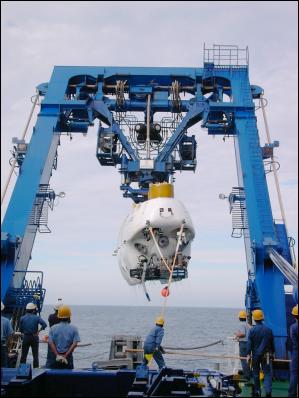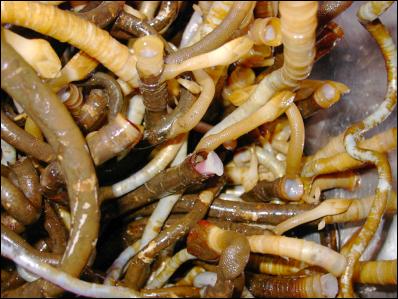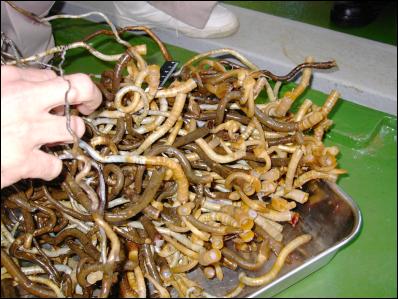Scientists Collect Submarine Volcano Creatures
Scientists Collect Creatures From Submarine
Volcano
Scientists from New Zealand and Japan have recovered a variety of deep-sea creatures while making the first-ever dive in a submersible into the crater of a seafloor volcano northeast of Bay of Plenty.

KIF_2628: The Shinkai 6500
submersible being recovered by its mother ship Yokosuka
after diving on Brothers volcano in the Kermadec Arc,
northeast of Bay of Plenty.

KIF_2633: A clump of tube
worms and long-neck barnacles recovered from the crater of
Bothers volcano, northeast of Bay of Plenty. Tubeworms are
reasonably common on the seafloor of the Pacific Ocean, but
this is the first time they have been found in the southern
part of the Kermadec Arc.

KIF_2632: Closeup of
tubeworms and long-neck barnacles that colonise areas
around volcanic vents on the seafloor. They live by
metabolising the hot, acidic, mineral-laden fluids being
pumped out of the vents.
Part-way through a six-dive programme, the scientists have collected numerous long-neck barnacles, shrimps, limpets, tubeworms, and crabs as well as "black smoker" chimneys packed with metallic minerals from inside an active crater.
Communities of hardy marine animals live close to seafloor vents that pump out hot, acidic, mineral-laden fluids.
It is early days, but the scientists believe some of the creatures they have collected may be new to science.
" It is the first time that tubeworms have been recorded in this part of the Kermadec Arc," said New Zealand project leader Cornel de Ronde of Geological and Nuclear Sciences Ltd (GNS).
" It will be interesting to see how closely they are related to other tubeworms found in the Pacific. Or indeed, if they are a new species."
The focus of four of the dives is the caldera (crater) of Brothers volcano, 400km northeast of White Island. Brothers is about three times the size of White Island, with its crater floor 1800m below the surface. It is one of the most active of New Zealand's many submarine volcanoes.
The scientists chose the crater of Brothers volcano for exploration because it has at least five very active vent sites. This offers a wide variety of fluids, gases, geological samples, and vent-related animals for filming and collection.
Brothers' crater is large, measuring 3km by 3.5km. Its jagged crater walls rise about 450m above the crater floor.
" As we descended, we first saw thick black smoke out the windows at 1600m. This means the hydrothermal plumes are rising 50 to 100 meters above the vents in Brothers volcano. That tells us straight away that we have vigorous hydrothermal venting directly below the sub."
Dr de Ronde said in places, the crater wall of Brothers was almost vertical and looked extremely unstable.
" There's evidence of collapsing and slumping inside the crater. We saw numerous slabs of rock about the size of a small car that had obviously fallen down the slope. Geologically, it's a very active place," he said from the mother ship, Yokosuka.
The trailblazing deep-sea exploration is a collaboration between Geological and Nuclear Sciences Ltd (GNS) and the Japan Agency for Marine-Earth Science and Technology (JAMSTEC). The project is part of a longterm GNS programme to find out more about the ocean floor within New Zealand's Exclusive Economic Zone.
JAMSTEC has brought the world's deepest-diving submersible, Shinkai 6500, to New Zealand for the project. The 26 tonne vessel can take a crew of three to the bottom of the ocean for eight hours at a time.
Typically, the submersible takes about an hour to reach a depth of 1800m and then spends five to six hours exploring at that depth before returning to the surface. Although it is pitch black at 1800m, the sub's powerful lights enable the scientists to see up to 6m through three small windows.
A notable feature inside the crater were "fields" of chimneys, sometimes numbering 50 or more, venting mineral-rich fluids at up to 300oC. Using the sub's praying mantis-like manipulator arms, the scientists collected several chimneys for analysis back on land. Many were 2m to 3m tall, with some reaching 6m in height.
" Chimneys grow continuously until they become unstable and fall over. Then the process starts again."
The scientists plan to make two dives on Healy volcano, about 35km south of Brothers, before finishing their voyage. Most of the cost of the 17-day project is being met by the government-owned research organisation JAMSTEC.


 Great Journeys New Zealand: Back By Popular Demand, The Southerner Returns
Great Journeys New Zealand: Back By Popular Demand, The Southerner Returns New Zealand Association of Scientists: Budget 2025 Robs Researchers To Pay For Regulation
New Zealand Association of Scientists: Budget 2025 Robs Researchers To Pay For Regulation Advertising Standards Authority: ASA 2024 Annual Report - Strengthening Consumer Protections With Effective Ad Self-Regulation
Advertising Standards Authority: ASA 2024 Annual Report - Strengthening Consumer Protections With Effective Ad Self-Regulation IRANZ: Budget Reaction – Time To Back Science With Long-Term Investment
IRANZ: Budget Reaction – Time To Back Science With Long-Term Investment Better Taxes for a Better Future: Budget Of Austerity Piles On Least Well-Off, Misreads Public Mood
Better Taxes for a Better Future: Budget Of Austerity Piles On Least Well-Off, Misreads Public Mood Nicola Gaston, The Conversation: NZ Budget 2025 - Science Investment Must Increase As A Proportion Of GDP For NZ To Innovate And Compete
Nicola Gaston, The Conversation: NZ Budget 2025 - Science Investment Must Increase As A Proportion Of GDP For NZ To Innovate And Compete


